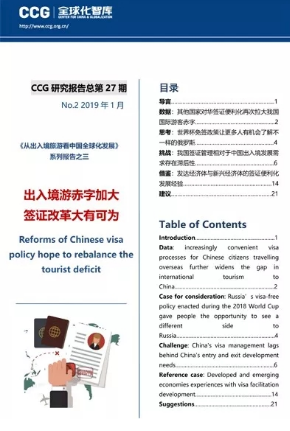CCG releases third report about inbound tourism with Ctrip.com
May 13 , 2019
On January 10, 2019, CCG and Ctrip (Ctrip) jointly released the 3rd edition of the series reports on outbound tourism and China’s globalization, focusing on “Reforming China’s Visa Policy to Reduce Tourism Deficit”. The report analyzes the impact of the new trend of visa electronicalization on the China’s widening tourism deficit. It also points out the challenges facing China’s visa policy and immigration management. Citing successful practice of various countries in visa policy innovation. the report suggests several measures for visa policy innovation to promote China’s globalization and show the world a more open China in the new era.

In 2018, six countries have implemented measures to facilitate Chinese citizens to obtain visa, making China’s passport more valuable and overseas travel an easier option for Chinese. Up to now, there have been 14 countries that formally implemented reciprocal visa-free policy with China for the holders of ordinary passports. A total of 15 countries unilaterally exempt Chinese citizens from visas, and 44 countries allow Chinese citizens to apply for visa on arrival, all of which have, to different extent, increased the number of inbound and outbound tourists. However, compared to Chinese traveling abroad, there is still a relatively smaller numboer of foreigners that visit China. China’s international tourism deficit is still widening up.
Promoting China’s inbound tourism is not only an important manifestation of China’s continued effort of reform and opening up, but also an effective way to support the “Belt and Road” initiative. In order to further reduce China’s international tourism deficit and globalization, it is vital to push forward China’s visa policy innovation and to facilitate entry and exit procedure. Therefore, CCG and Ctrip conducted such as research that brings in international perspectives to analyze the best practice of visa policy and immigration management in other countries and identifies the challenges to China, to make recommendations for further reform and opening up. Based on the extensive data and interpreration, the report summarizes the means to achieve visa innovation, as it is an important signal to show China’s globalization and deepened reform and opening up.
Based on the research on global visa policy development trends and China’s inbound and outbound tourism data, the report pointed out that although the number of China’s inbound tourists have increased to a certain degree compared with previous years, the international tourism deficit has been also growing significantly. In 2016, China’s international tourism deficit reached 40.26 million (excluding the data of border residents’ entires), an increase of 27.26% from 3.3 million in 2015. It is expected to be further widen in the next five years, likely to exceed 100 million.
The comparative studies of China and other countries’ visa policy systems and the research on the relationship between visa policy and international tourism show the shortcomings in China’s current visa management and major challenges, including conservative categorization of visa types, lack of optimized visa application platform, visa exemption policy that is not open enough, and uncoordinated visa and entry-exit management. From a number of case studies such as Russia’s visa exemption policy during the World Cup and innovative visa policies in developed and emerging economies, the report draws some lessons to both simplify visa processing procedure and attract foreign tourists to eventually promote globalization.
The report points out that the open and innovation of visa policy is a key measure for China to be further involved in globalization. Therefore, it suggests the measures in five aspects to achieve this goal, which are 1) changing concept from focusing on document management to population management; 2) reforming visa policy and innovate visa system by establishing a self-application platform; 3) establishing cooperative operation to enlist social resource to build information management platforms; 4) authorizing the State Immigration Administration to take a leading role in the coordination of China’s exit-entry management; 5) stepping up tourism promotion through partnership building and private sector participation.
CCG and Ctrip jointly conducted research and released the report series on China’s globalization and inbound and outbound tourism, aiming to find the core problem of China’s inbound tourism and solutions. The 1st report “Insufficient growth in inbound tourism and China’s tourism deficit” lays out extensive data and thorough analysis about current situation of China and global tourism industry. It pointed out the imbalanced development of inbound and outbound tourism. The 2nd report is focused on promoting the rapid development of China’s inbound tourism, summarizing on the basis of in-depth research and analysis of international tourist groups, which summarizes the finding of a survey on international tourist groups, identifies main problems affecting China’s inbound tourism, and proposes solution to make improvement. The 3rd report is intended to identify the key factors affecting tourism development, analyze the causes, and propose policy advice to promote tourism-related policy and China’s globalization.






